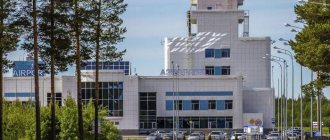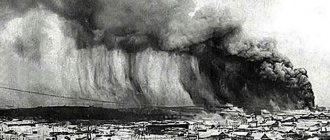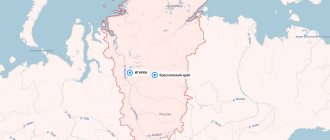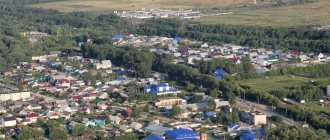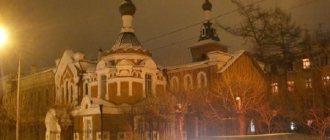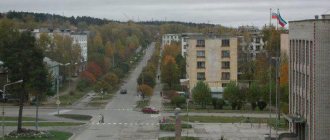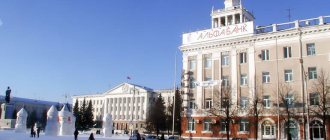This term has other meanings, see Soviet.
| City Soviet Flag | Coat of arms |
| A country | Russia, Russia |
| Subject of the federation | Khanty-Mansiysk Autonomous Okrug - YugraKhanty-Mansiysk Autonomous Okrug - Yugra |
| Municipal district | Soviet |
| urban settlement | Soviet |
| Coordinates | 61°22′00″ n. w. 63°34′00″ E. d. / 61.36667° n. w. 63.56667° E. d. / 61.36667; 63.56667 (G) [www.openstreetmap.org/?mlat=61.36667&mlon=63.56667&zoom=12 (O)] (Z)Coordinates: 61°22′00″ N. w. 63°34′00″ E. d. / 61.36667° n. w. 63.56667° E. d. / 61.36667; 63.56667 (G) [www.openstreetmap.org/?mlat=61.36667&mlon=63.56667&zoom=12 (O)] (I) |
| Chapter | Zhukov Alexander Yurievich |
| Based | in 1963 |
| City with | 1996 |
| Square | 383.255 km² |
| Population | ↗29,179[1] people (2016) |
| Names of residents | soviet, soviet, soviet |
| Timezone | UTC+5 |
| Telephone code | +7 34675 |
| Postcode | 628240, 628241, 628242 |
| Vehicle code | 86 |
| OKATO code | [classif.spb.ru/classificators/view/okt.php?st=A&kr=1&kod=71124604 71 124 604] |
| Official site | [www.sovinet.ru inet.ru] |
| Soviet Moscow |
| : Incorrect or missing image Khanty-Mansiysk Soviet |
K: Settlements founded in 1963
Sovetsky
- a city in the Khanty-Mansiysk Autonomous Okrug - Ugra, Tyumen Region.
Population - 29,179[1] people. (2016).
Fauna
The fauna is typical for the taiga zone of Russia. The vertebrate fauna includes 369 species. Mammals are represented by 60 species, 28 of which are commercial. The most common and economically valuable are: fox, arctic fox, squirrel, sable, marten, ermine, weasel, polecat, mink, weasel, otter, hare, wild reindeer, elk, etc. Wolverine and West Siberian river are listed in the Red Book of Russia beaver.
Ornithofauna with 256 bird species, including 206 resident and nesting species. The most numerous orders are passeriformes, chariformes and anseriformes. The basis of the hunting fauna (48 species) is formed by geese, wood grouse, black grouse, hazel grouse, partridges, ducks, and waders. Of the predators, special mention should be made of the vulture hawk, marsh harrier, and long-eared owl. There are rare species listed in the Red Book: Dalmatian Pelican, Black Stork, Common Flamingo, Lesser Lesser Lesser Lesser Lesser Lesser White-fronted Lesser, Golden Eagle, Peregrine Falcon, Black Crane, Siberian Crane (White Crane), Slender-billed Curlew, White-tailed Eagle, Osprey, Gyrfalcon, Brent Goose, Red-breasted Goose.
There are 42 species of fish in rivers and lakes. Only 19 of them are commercial - these are sterlet, lelma, muksun, peled (cheese), whitefish (pizhyan), Sosvinskaya herring (tugun), burbot, pike, ide, roach, bream, dace, perch, ruff , gold and silver crucian carp.
The huge number of blood-sucking insects is a significant nuisance for domestic animals and people working outdoors. Mosquitoes appear in late May - mid-June, and their mass emergence occurs in early July. By the end of August, the number and activity of mosquitoes decreases significantly. The period of greatest activity of midges, when they attack people, occurs in the second half of summer.
Population[ | ]
| Population | |||||||
| 1970[8] | 1979[9] | 1989[10] | 1996[10] | 2000[10] | 2001[10] | 2002[11] | 2003[10] |
| 5897 | ↗13 674 | ↗21 100 | ↘20 900 | ↗22 200 | ↗22 900 | ↗23 230 | ↘23 200 |
| 2005[10] | 2006[10] | 2007[10] | 2008[12] | 2009[13] | 2010[14] | 2011[10] | 2012[15] |
| ↗24 500 | ↗24 800 | ↗25 200 | ↗25 600 | ↗25 974 | ↗26 495 | ↗26 500 | ↗27 116 |
| 2013[16] | 2014[17] | 2015[18] | 2016[19] | 2017[20] | 2018[21] | 2019[22] | 2020[23] |
| ↗27 631 | ↗28 087 | ↗28 683 | ↗29 179 | ↗29 456 | ↗29 575 | ↗29 624 | ↘29 293 |
| 2021[2] | |||||||
| ↗29 452 | |||||||
As of January 1, 2022, in terms of population, the city was in 509th place out of 1,116[24]cities of the Russian Federation[25].
Story
In 1963, during the construction of the Ivdel-Ob railway, the village of Sovetsky was founded and a timber industry enterprise was created.
The newspaper “Leninskaya Tribuna” in March 1963 described the first months of the existence of the Sovetsky village as follows:
“In the dead of night in February 1962, a small detachment of builders reached the future Kartop station. Taiga greeted the scouts gloomily. A blizzard was raging, centuries-old pines were groaning from the wind. With difficulty the builders built the hut. And in the morning the first pine tree fell with a noise. The foundation of the village, which today is called Sovetsky, began. A month later, there were already 9 houses in the pine forest...”
The first streets of the city were Lesnaya and Zoya Kosmodemyanskaya. A year later, in February 1963, there were already 4 streets, a population of 1,500 people, and a timber industry enterprise was created. In August 1963, the first train arrived (instead of the station building there were 2 trailers).
By the decision of the Executive Committee of the Tyumen Regional Council of Working People's Deputies
No. 37 of January 21, 1963 “On classifying the villages of Komsomolsky and Sovetsky of the Kondinsky district of the Khanty-Mansiysk National Okrug to the category of urban-type working villages, the formation of the Komsomolsky and Sovetsky village Councils and the abolition of the Komsomolsky Village Council” the
village Sovetsky is classified as an urban-type working settlement. The village Council of Workers' Deputies was formed.
This decision can be officially considered a document on the creation of the village of Sovetsky, and the date January 21 is the day of its foundation.
August 1965
A new bakery was launched on the street. Lenin with mechanized sifting of flour and kneading dough.
The first bakery was built in 1963 on the corner of Lenina and Lesnaya streets, where all the work was done by hand (water was carried from wells, the oven was heated with wood)
02/15/1968
In accordance with the Decree of the Presidium of the Supreme Council of the RSFSR, the Sovetsky district was formed as part of the Khanty-Mansiysk National Okrug, which included the workers’ villages of Komsomolsky, Pionersky, Sovetsky.
1972
In August, a memorial complex was opened in the center of Sovetsky. Capsules with an appeal from young people to the future generation were immured in it (capsules should be opened in 2022). In October, the dairy began operating, providing social institutions with milk, kefir, sour cream and cottage cheese, producing up to 700 tons of products annually
at the anniversary exhibition of the 70th anniversary of the Khanty-Mansi Autonomous Okrug, in December 2000, the Soviet Dairy Plant took 3rd place among the food industry enterprises of the district. At that time, the plant employed 25 people, the director was M.A. Gracheva.
As of January 1, 1990, in the Sovetsky district there were 8 workers’ villages (Agirish, Zelenoborsk, Kommunistichesky, Komsomolsky, Malinovsky, Pionersky, Sovetsky, Taezhny) and one village council (Alyabyevsky). November 26, 1990,
on the initiative of a resident of Sovetsky V.G. Maltseva created the first community of believers. Fundraising began for the construction of the temple (the construction of which will begin in 1993)
In the summer of 1999, as part of the “For Faith and Fidelity” movement, a memorial cross was erected at the “Mother’s Order” memorial by an all-Russian religious procession.
12/16/1996
The Duma of the Khanty-Mansi Autonomous Okrug adopted and signed the law “On classifying the urban-type settlement Sovetsky as a city of district significance.” In accordance with the Law of the Khanty-Mansi Autonomous Okrug “On classifying the city of Yugorsk as a city of district significance,” the city of Yugorsk is leaving the Sovetsky district.
12/23/1996
the village of Sovetsky was renamed the city of Sovetsky.
Based on Article 12 of the Charter of the municipal formation of the Sovetsky district and the resolution of the head of the municipal formation of the Sovetsky district dated November 18, 1998 No. 216 “On approval of the Regulations on the territorial divisions of the administration of the municipal formation of the Sovetsky district,” the administration of the village of Sovetsky was transformed into the administration of the city of Sovetsky.
Industry and transport
All large enterprises of Sovetsky are, in one way or another, connected with wood and woodworking. They produce furniture, wooden panels (glued), furniture veneer, and sets of prefabricated wooden houses, which are manufactured at the factory. There are food enterprises and construction organizations.
There is an airport in Sovetsky, whose planes fly to Moscow, Yekaterinburg, Tyumen, Beloyarsk, and St. Petersburg. Not far from the city is the Verkhnekondinskaya station, which lies on the line connecting the Ural region and the Ob region. Two concrete roads Sovetsk–Taiozhny were built through Yugorsk and Sovetsk–Uray.
Notes
- ↑ 123
www.gks.ru/free_doc/doc_2016/bul_dr/mun_obr2016.rar Population of the Russian Federation by municipalities as of January 1, 2016 - [demoscope.ru/weekly/ssp/rus70_reg2.php All-Union Population Census of 1970 The size of the urban population of the RSFSR, its territorial units, urban settlements and urban areas by gender.] (Russian). Demoscope Weekly. Retrieved September 25, 2013. [www.webcitation.org/6GDOiMstp Archived from the original on April 28, 2013].
- [demoscope.ru/weekly/ssp/rus79_reg2.php All-Union Population Census of 1979 The size of the urban population of the RSFSR, its territorial units, urban settlements and urban areas by gender.] (Russian). Demoscope Weekly. Retrieved September 25, 2013. [www.webcitation.org/6GDOjhZ5L Archived from the original on April 28, 2013].
- ↑ 123456789
www.MojGorod.ru/hmao/sovetskijh/index.html People's encyclopedia “My City”. Sovetsky (Khanty-Mansiysk Autonomous Okrug) - [www.perepis2002.ru/ct/doc/1_TOM_01_04.xls All-Russian Population Census 2002. Volume. 1, table 4. Population of Russia, federal districts, constituent entities of the Russian Federation, districts, urban settlements, rural settlements - regional centers and rural settlements with a population of 3 thousand or more]. [www.webcitation.org/65AdCU0q3 Archived from the original on February 3, 2012].
- [www.gks.ru/bgd/regl/b08_14t/IssWWW.exe/Stg/ur/05-00.htm Cities of the Khanty-Mansiysk Autonomous Okrug - Ugra (number of inhabitants - estimate as of January 1, 2008, thousand people) ]. Retrieved July 11, 2016. [www.webcitation.org/6ivWjf9ee Archived from the original on July 11, 2016].
- [www.gks.ru/bgd/regl/B09_109/IssWWW.exe/Stg/d01/tabl-21-09.xls Number of permanent population of the Russian Federation by cities, urban-type settlements and districts as of January 1, 2009]. Retrieved January 2, 2014. [www.webcitation.org/6MJmu0z1u Archived from the original on January 2, 2014].
- [tumstat.gks.ru/wps/wcm/connect/rosstat_ts/tumstat/resources/22904e804154168ab3dff7367ccd0f13/part+1.rar All-Russian population census 2010. Population size and its distribution in the Tyumen region]. Retrieved May 10, 2014. [www.webcitation.org/6PTJWMhJj Archived from the original on May 10, 2014].
- [www.gks.ru/free_doc/doc_2012/bul_dr/mun_obr2012.rar Population of the Russian Federation by municipalities. Table 35. Estimated resident population as of January 1, 2012]. Retrieved May 31, 2014. [www.webcitation.org/6PyOWbdMc Archived from the original on May 31, 2014].
- [www.gks.ru/free_doc/doc_2013/bul_dr/mun_obr2013.rar Population of the Russian Federation by municipalities as of January 1, 2013. - M.: Federal State Statistics Service Rosstat, 2013. - 528 p. (Table 33. Population of urban districts, municipal districts, urban and rural settlements, urban settlements, rural settlements)]. Retrieved November 16, 2013. [www.webcitation.org/6LAdCWSxH Archived from the original on November 16, 2013].
- [www.gks.ru/free_doc/doc_2014/bul_dr/mun_obr2014.rar Table 33. Population of the Russian Federation by municipalities as of January 1, 2014]. Retrieved August 2, 2014. [www.webcitation.org/6RWqP50QK Archived from the original on August 2, 2014].
- [www.gks.ru/free_doc/doc_2015/bul_dr/mun_obr2015.rar Population of the Russian Federation by municipalities as of January 1, 2015]. Retrieved August 6, 2015. [www.webcitation.org/6aaNzOlFO Archived from the original on August 6, 2015].
- taking into account the cities of Crimea
- [www.gks.ru/free_doc/doc_2016/bul_dr/mun_obr2016.rar Population of the Russian Federation by municipalities as of January 1, 2016. Table “31. Population of cities and towns by federal districts and constituent entities of the Russian Federation as of January 1, 2016.” RAR archive (1.0 MB)]
Content
- 1. History
- 2 Population
- 3 Industry
- 4 Educational institutions
- 5 Attractions
- 6 Authorities and management 6.1 History of the names of city authorities
- 6.2 History of city leaders
An excerpt characterizing the Soviet (Khanty-Mansi Autonomous Okrug)
Natasha, afraid that her brother would do something terrible, rode not far behind him in excitement. Seeing that the enemies were bowing in a friendly manner, she drove up to them. Ilagin raised his beaver cap even higher in front of Natasha and, smiling pleasantly, said that the Countess represented Diana both by her passion for hunting and by her beauty, about which he had heard a lot. Ilagin, in order to make amends for the guilt of his hunter, urgently asked Rostov to go to his eel, which was a mile away, which he kept for himself and in which, according to him, there were hares. Nikolai agreed, and the hunt, having doubled in size, moved on. It was necessary to walk to the Ilaginsky eel through fields. The hunters straightened out. The gentlemen rode together. Uncle, Rostov, Ilagin secretly glanced at other people's dogs, trying so that others would not notice, and anxiously looked for rivals for their dogs among these dogs. Rostov was especially struck by her beauty by a small pure-dog, narrow, but with steel muscles, a thin muzzle and bulging black eyes, a red-spotted bitch in Ilagin’s pack. He had heard about the agility of the Ilagin dogs, and in this beautiful bitch he saw his Milka’s rival. In the middle of a sedate conversation about this year's harvest, which Ilagin started, Nikolai pointed out to him his red-spotted bitch. - This bitch is good! – he said in a casual tone. - Rezva? - This? Yes, this is a good dog, it catches,” Ilagin said in an indifferent voice about his red-spotted Erza, for which a year ago he gave his neighbor three families of servants. “So you, Count, don’t boast about threshing?” – he continued the conversation he had started. And considering it polite to repay the young count in kind, Ilagin examined his dogs and chose Milka, who caught his eye with her width. - This black-spotted one is good - okay! - he said. “Yes, nothing, he’s jumping,” answered Nikolai. “If only a seasoned hare ran into the field, I would show you what kind of dog this is!” he thought, and turning to the stirrup man said that he would give a ruble to anyone who suspected, that is, found a lying hare. “I don’t understand,” Ilagin continued, “how other hunters are envious of the beast and the dogs.” I'll tell you about myself, Count. It makes me happy, you know, to take a ride; Now you’ll get together with such a company... what’s better (he again took off his beaver cap in front of Natasha); and this is to count the skins, how many I brought - I don’t care! - Well, yes. - Or so that I would be offended that someone else’s dog catches it, and not mine - I just want to admire the baiting, right, Count? Then I judge... “Atu - him,” a drawn-out cry was heard at that time from one of the stopped Greyhounds. He stood on a half-mound of stubble, raising his arapnik, and once again repeated in a drawn-out manner: “A—tu—him!” (This sound and the raised arapnik meant that he saw a hare lying in front of him.) “Ah, he suspected it, it seems,” Ilagin said casually. - Well, let's poison him, Count! - Yes, we need to drive up... yes - well, together? - Nikolai answered, peering at Erza and the red Scolding uncle, two of his rivals with whom he had never managed to match his dogs. “Well, they’ll cut my Milka out of my ears!” he thought, moving towards the hare next to his uncle and Ilagin. - Seasoned? - Ilagin asked, moving towards the suspicious hunter, and not without excitement, looking around and whistling to Erza... - And you, Mikhail Nikanorych? - he turned to his uncle. The uncle rode frowning. - Why should I meddle, because yours are pure marching! - in the village they pay for the dog, your thousands. You try on yours, and I’ll take a look! - Scold! On, on,” he shouted. - Swearing! - he added, involuntarily using this diminutive to express his tenderness and hope placed in this red dog. Natasha saw and felt the excitement hidden by these two old men and her brother and was worried herself. The hunter stood on the half-hill with a raised arapnik, the gentlemen approached him at a step; the hounds, walking on the very horizon, turned away from the hare; the hunters, not the gentlemen, also drove away. Everything moved slowly and sedately. -Where is your head lying? - Nikolai asked, approaching a hundred paces towards the suspicious hunter. But before the hunter had time to answer, the hare, sensing the frost by tomorrow morning, could not stand still and jumped up. A pack of hounds on bows, with a roar, rushed downhill after the hare; from all sides the greyhounds, who were not in the pack, rushed at the hounds and the hare. All these slowly moving hunters are screaming: stop! knocking down the dogs, the greyhounds shout: atu! guiding the dogs, they galloped across the field. Calm Ilagin, Nikolai, Natasha and uncle flew, not knowing how or where, seeing only dogs and a hare, and only fearing to lose sight of the course of the persecution even for a moment. The hare was seasoned and playful. Jumping up, he did not immediately gallop, but moved his ears, listening to the screaming and stomping that suddenly came from all sides. He jumped ten times slowly, allowing the dogs to approach him, and finally, having chosen the direction and realizing the danger, he put his ears to the ground and rushed at full speed. He lay on the stubble, but in front there were green fields through which it was muddy. The two dogs of the suspicious hunter, who were closest, were the first to look and lay after the hare; but they had not yet moved far towards him, when the Ilaginskaya red-spotted Erza flew out from behind them, approached a dog's distance, with terrible speed attacked, aiming at the hare's tail and thinking that she had grabbed it, rolled head over heels. The hare arched his back and kicked even harder. Wide-bottomed, black-spotted Milka came out from behind Erza and quickly began to sing to the hare. - Honey! mother! – Nikolai’s triumphant cry was heard. It seemed that Milka would strike and catch the hare, but she caught up and rushed past. The Rusak moved away. The beautiful Erza swooped in again and hung over the hare’s very tail, as if trying to grab him by the back thigh so as not to make a mistake now. - Erzanka! sister! – Ilagin’s voice was heard crying, not his own. Erza did not heed his pleas. At the very moment when one should have expected her to grab the hare, he whirled and rolled out to the line between the greenery and the stubble. Again Erza and Milka, like a pair of drawbars, aligned themselves and began to sing to the hare; at the turn it was easier for the hare; the dogs did not approach him so quickly. - Scold! Swearing! Pure march! - shouted at that time another new voice, and Rugai, his uncle’s red, humpbacked dog, stretching out and arching his back, caught up with the first two dogs, moved out from behind them, kicked with terrible selflessness right over the hare, knocked him off the line onto the green, Another time he pushed even harder through the dirty greens, drowning up to his knees, and you could only see how he rolled head over heels, getting his back dirty in the mud, with the hare. The star of dogs surrounded him. A minute later everyone was standing near the crowded dogs. One happy uncle got down and walked away. Shaking the hare so that the blood would drain, he looked around anxiously, running his eyes, unable to find a position for his arms and legs, and spoke, not knowing with whom or what. “This is a matter of march... here is a dog... here he pulled out everyone, both thousandths and rubles - a pure matter of march!” he said, gasping and looking around angrily, as if scolding someone, as if everyone were his enemies, everyone had offended him, and only now he finally managed to justify himself. “Here are the thousandths for you - a pure march!” - Scold me, fuck off! - he said, throwing the cut-off paw with the earth stuck on it; – deserved it – pure march! “She pulled out all the stops, gave three runs on her own,” Nikolai said, also not listening to anyone, and not caring whether they listened to him or not. - What the hell is this! - said Ilaginsky the stirrup. “Yes, as soon as she stopped short, every mongrel will catch you from stealing,” said Ilagin at the same time, red-faced, barely catching his breath from the galloping and excitement. At the same time, Natasha, without taking a breath, squealed joyfully and enthusiastically so shrilly that her ears were ringing. With this screech she expressed everything that other hunters also expressed in their one-time conversation. And this squeal was so strange that she herself should have been ashamed of this wild squeal and everyone should have been surprised by it if it had been at another time. The uncle himself pulled the hare back, deftly and smartly threw him over the back of the horse, as if reproaching everyone with this throwing, and with such an air that he didn’t even want to talk to anyone, sat on his kaurago and rode away. Everyone except him, sad and offended, left and only long after could they return to their former pretense of indifference. For a long time they looked at the red Rugay, who, with his hunchbacked back and dirt stained, rattling his iron, with the calm look of a winner, walked behind the legs of his uncle’s horse. “Well, I’m the same as everyone else when it comes to bullying. Well, just hang in there!” It seemed to Nikolai that the appearance of this dog spoke. When, long after, the uncle drove up to Nikolai and spoke to him, Nikolai was flattered that his uncle, after everything that had happened, still deigned to speak with him. When Ilagin said goodbye to Nikolai in the evening, Nikolai found himself at such a far distance from home that he accepted his uncle’s offer to leave the hunt to spend the night with him (with his uncle), in his village of Mikhailovka. - And if they came to see me, it would be a pure march! - said the uncle, even better; you see, the weather is wet, the uncle said, if we could rest, the countess would be taken in a droshky. “Uncle’s proposal was accepted, a hunter was sent to Otradnoye for the droshky; and Nikolai, Natasha and Petya went to see their uncle. About five people, large and small, courtyard men ran out onto the front porch to meet the master. Dozens of women, old, big and small, leaned out from the back porch to watch the approaching hunters. The presence of Natasha, a woman, a lady on horseback, brought the curiosity of the uncle's servants to such limits that many, not embarrassed by her presence, came up to her, looked into her eyes and in her presence made their comments about her, as if about a miracle being shown, which is not a person, and cannot hear or understand what is said about him. - Arinka, look, she’s sitting on her side! She sits herself, and the hem dangles... Look at the horn! - Fathers of the world, that knife... - Look, Tatar! - How come you didn’t somersault? – said the bravest one, directly addressing Natasha. The uncle got off his horse at the porch of his wooden house overgrown with a garden and, looking around at his household, shouted imperiously that the extra ones should leave and that everything necessary for receiving guests and hunting would be done.
Sovetsk
Sovetsk is a small city located in the Baltic historical region of East Prussia, on the border with Lithuania. This is the northernmost settlement of the Kaliningrad region of Russia. On the bridge over the Neman there is a border checkpoint for travelers heading to the neighboring country. The area is open to vehicular and pedestrian traffic. A city with a long history, known until 1946 as Tilsit, suffered catastrophically during the Great Patriotic War. But from the pre-war buildings, architectural pearls have still been preserved here, capable of becoming one of the tourist attractions.
Save on your trip to Sovetsk!
Video: Sovetsk from above
Basic moments
In world history, the city of Sovetsk is known as the place where the Tilsit Peace Agreement was signed in 1807 between the Russian Empire and Napoleonic France. This treaty significantly changed the fate of many European countries. Tilsit also became famous for the fact that the recipe for the famous Tilsiter cheese, which gained popularity among gourmets all over the world, was invented here.
Recently, local authorities have been making a lot of efforts to develop tourism in the historical cities of the Kaliningrad region. Among the locations included in the national tourism project “Imperial Route” was the former Tilsit, because at one time the Russian sovereigns Peter I and Alexander I, the French emperor Napoleon Bonaparte, and Prussian and German crowned persons visited here. In modern Sovetsk, the ruins of the medieval citadel of the Teutonic Order, the Queen Louise Bridge, and Prussian houses of the 19th - first half of the 20th centuries have been preserved, most of which are in need of repair.
As part of the cross-border cooperation program with the European Union, primarily with neighboring Lithuania, plans have been outlined for the restoration of cultural sites and historical buildings, and the construction of a modern cultural and leisure center has been completed. Over the past two decades, new churches belonging to different denominations have appeared in Sovetsk, and many monuments have been restored. The city has museums, theaters, cinemas, and small hotels offering decent service.
Victory Street in Sovetsk
History of Sovetsk
Historians consider the predecessor of Sovetsk to be a fortified settlement of one of the ancient Prussian tribes, built in the 6th century. German archaeologists excavated the remains of early medieval buildings and an extensive burial ground on the western outskirts of the city in the early 1930s.
From historical chronicles it is known that military engineers of the Teutonic Order erected the first floating bridge across the Neman here in 1313, and in 1410 they built a stone castle near the mouth of the Tilse River, which flows into the Neman. The city of Tilsit arose near the walls of the citadel. The Tilze (Tylzha) River gave it its name.
Trade flourished in the port village and fairs were held. Timber was a popular commodity - ship timber was floated along the rivers into the harbor. In 1511, the Grand Master of the Order ordered the first hotel to be built here. On November 2, 1552, the Prussian Duke Albrecht of Brandenburg signed a charter elevating the sprawling village to city status. This event is considered the founding date of Tilsit.
At the beginning of the 18th century, the region was depopulated after a plague epidemic. The king invited settlers from other countries to East Prussia. Mennonite refugees from Holland and Switzerland came to Tilsit to escape religious conflicts. Among them were experienced cheese makers who established the production of local Tilsiter cheese, which became widely known in Europe.
At the end of the 19th century, a Swiss cheese maker who visited East Prussia brought the Tilsiter recipe home. Several varieties of this delicious cheese are produced in the Alpine country to this day under the Tilsiter Switzerland brand. It is interesting that this family business is continued by the descendants of that same traveler cheesemaker. The cheese wheels are covered with a dark burgundy crust. The surface of the elite Alpen Tilsiter variety is rubbed with white wine infused with spices. Their own Tilsit cheese is also made in Germany, Poland, Russia, Ukraine and even in Australia. Everywhere the recipe is slightly different. Gourmets have placed Tilsiter in the top 20 best cheeses in the world.
The provincial town of Tilsit suddenly entered world history in 1807, when the army of Napoleon Bonaparte defeated Prussian troops and the 40,000-strong army of the Russian Empire sent by Tsar Alexander I to help the allied Prussia. The battle took place near the city of Friedland, 43 km southeast of Konigsberg. In a fierce battle, Russian soldiers behaved so courageously that a new insignia for bravery was established in Russia, which later became known as the soldier's St. George's Cross.
After the victorious battle, the French emperor arrived in Tilsit, where he met with the Russian autocrat. During the negotiations, the monarchs signed a document that reshaped Prussia, which had almost disappeared from the map of Europe - the Tilsit Peace Treaty. The negotiations were also attended by the King of Prussia, Frederick William III, and his wife, Queen Louise of Mecklenburg. The charming crowned beauty managed to convince Napoleon to preserve the statehood of Prussia, which had lost a significant part of its lands. This event is captured in the painting of a contemporary, French painter Nicolas Gosse, “The Tilsit Rendezvous.” The canvas depicts Napoleon, politely taking off his cocked hat. He holds the hand of the queen, who bows her head slightly. Nearby, the Prussian king straightened up impassively; The blond Russian emperor looks at Napoleon with a slight smile. Louise went down in the history of the kingdom as a true guardian angel of the country and remained in the national memory for a long time.
Historical city center (1930)
In the 19th century, Tilsit became more beautiful: church bell towers rose in the squares, the streets were lined with beautifully decorated multi-story residential buildings and public buildings. Hotels, restaurants received guests, and a drama theater operated. A Tilsit cheese factory operated in the city and high-quality beer was produced.
In 1865, a railway line leading through Königsberg to Berlin was built to Tilsit. Ten years later, the banks of the Neman were connected by a railway bridge, the tracks were continued to Memel (Klaipeda). By the beginning of the 20th century, a passenger river port and a cargo harbor operated in Tilsit, and a tram ran along the streets. In the 1920s an airfield was built here. It served as a base for regional passenger flights and also provided intermediate refueling facilities for long-haul flights. Here, among other things, planes landed on flights Moscow - Berlin, Leningrad - Koenigsberg - Berlin.
During World War II, the local airfield was converted into a Luftwaffe military air base. When Hitler's Wehrmacht crossed the border of the USSR in June 1941, within a few hours the city was subjected to a massive raid by Soviet bombers.
Soviet soldiers entered the dilapidated Tilsit in January 1945. In July 1946, the city received a symbolic name - “Sovetsk”. At the same time, the German population was deported to Germany, and the first trains with immigrants from different regions of the USSR arrived in the city. They could not be called “new residents”: there was practically nowhere to live in the bombed city, approximately three-quarters of the streets lay in ruins.
The main efforts of workers and engineers were concentrated on the restoration of industrial structures. The destroyed residential areas were not restored, but were dismantled into bricks. Construction materials, which were in short supply at that time, were sent for the reconstruction of buildings in Leningrad, Minsk and other affected cities in the western regions of the country. Today, the preserved Prussian-German heritage seems to be a serious capital capable of turning Sovetsk into an attractive historical and cultural center.
Geography and climate
The border city of Sovetsk is located on the Lower Neman Plain, 120 km northeast of Kaliningrad, at the confluence of the Tylzha River with the Neman. Sovetsk has a population of 38,517 (2021) and has the status of a city of regional significance. There are no other settlements in the Soviet urban district. The nearest Russian cities outside the district are the regional centers of Neman (7 km to the southeast) and Slavsk (7 km to the southwest).
On the opposite northern bank of the Neman River, along which the border with Lithuania passes, is the city of Panyamune. From Sovetsk the Queen Louise Bridge leads across the river to it. There is a border checkpoint at the bridge crossing. Panyamune is the smallest town in Lithuania, with only 265 people living there. Until 1946, it was part of the city limits of Tilsit as a district beyond the river.
Although there are two rivers flowing in Sovetsk, you won’t be able to swim in them. There is an abandoned 100-meter city beach on the left bank of the Tylzha River. Currently it is not developed; the coast is overgrown with bushes and grass. Swimming in the river is prohibited. The ban was imposed by the regional Rospotrebnadzor: bacteria dangerous to health were found in the water. The soil on the beach is also contaminated; the content of toxic zinc in the sand is exceeded. The closest beach resort to Sovetsk is Zelenogradsk. The distance between cities is 142 km.
Sovetsk has a humid continental climate. In summer the city is quite cool, the air temperature fluctuates around +16. +20 °C. Only occasionally does the air temperature rise to +25. +30 °C. Autumn here is warm and rainy. Winters are mild and snowy; the average temperature in January-February is –3. –2 °С. There are short-term arctic cyclones that significantly lower air temperatures. During the extreme frost for the region, -33 °C was recorded.
Sights of Sovetsk
Sovetsk, which is predicted to have a happy tourist future, combines in its architectural appearance the features of the Prussian, Soviet and modern eras. In the post-war period, the city was built up with featureless residential buildings. Today they habitually coexist with dilapidated Prussian houses of the 19th – first half of the 20th centuries, requiring urgent repairs. Only in recent years have modern buildings with a strong architectural identity begun to appear here. These include, for example, cultural.
According to the recollections of contemporaries, after the war, the surviving churches, bell towers, and ancient fortifications were dismantled brick by brick. For obvious reasons, German cultural, historical and architectural monuments were ruthlessly and vindictively demolished at that time. Thus, a beautiful sculpture of the Prussian Queen Louise was destroyed, a monument to the outstanding German poet of the 19th century Maximilian von Scheckendorff, born in Tilsit, and other “ideologically alien” monuments were destroyed. Many beautiful buildings, which today await restoration, have been preserved only because they were used as housing for immigrants from different parts of the USSR.
Villa Franka Müller-Stahl House Queen Louise Theater Building
Among the dull buildings of Soviet times, you can unexpectedly find an ancient German church left without a roof, a luxurious baroque building of the Queen Louise Theater, Villa Franca with an unusual decor in the style of northern mannerism, a picturesque mansion that once belonged to a Masonic lodge.
Tram-monument in Sovetsk
Among the already restored buildings, a former apartment building, located on the pedestrian Pobeda Street, the main walking artery of Sovetsk, shines. Its façade is decorated with a stone sculpture of a knight of impressive size, balconies with wrought-iron grilles, mascarons, and other spectacular details. On the same street you can see a monument to the Tilsit tram. It was installed in 2012. On the windows of the old red carriage there are enlarged photographs of pre-war Tilsit and a banner with a brief history of the local tram that ran around the city from 1901 to 1944. Nearby rises a cast-iron overhead contact pole, the rails are lined with stone paving stones.
On Iskra Street, on the site of the destroyed Church of the Resurrection of Mary, the Catholic Church of the Resurrection of Christ with a high hipped bell tower now flaunts. It was erected in 2000 with funds from the Lithuanian Catholic community. The five-domed Orthodox church, consecrated in 2007 in the name of the Three Saints (Kaliningradskoye Shosse, 10), is clearly visible from all corners of the city. It was built in the Russian-Byzantine style. The temple has three chapels - Basil the Great, John Chrysostom and Gregory the Theologian.
Monument to Queen Louise in Jakobsruhe Park
In 2014, the neglected Jakobsruhe Historical Park was put in order. At the same time, a restored monument to Queen Louise appeared here. The original 8-meter white marble monument adorned the central park alley from 1900 to 1945. It was created by the famous Berlin sculptor Gustav Eberlein. The statue served as Tilsit’s calling card; its images were reproduced on postcards and in tourist guides. A copy of the monument was made by St. Petersburg sculptors Pavel Ignatiev and Denis Prasolov. Now the elegant sculpture of the queen is once again a symbol of the city and its tourist attraction.
The drawbridge across the Neman, opened in 1907, is also associated with the name of Queen Louise. Its length was 416 m, the structure was supported by three steel arches. The entrance to the bridge from Tilsit is decorated with a monumental portal in the Baroque style, echoing the architecture of the German church that towered on the coastal Market Square. Today, the Queen Louise Bridge is one of the main attractions of Sovetsk.
At the end of 1944, when the advancing Soviet troops entered the territory of East Prussia, German sappers blew up the spans of the bridge. However, the monumental entrance portal with towers survived, although it lost many decorative elements. The elegant arched structures that supported the bridge deck have not been preserved. Subsequently, the crossing was hastily rebuilt using wooden beams, and in the 1960s, concrete slabs supported by numerous piles were laid across the river. Today, the portal of the Queen Louise Bridge is called the gateway to Europe: the bridge serves as a border crossing to neighboring Lithuania.
The city has preserved three ancient water towers of original architecture, built of durable brick. A two-tier square tower built in 1912 rises on Nekrasova Street, 4-A. The round conical tower on Timiryazev Street was erected in 1898. Another round tower is located on Pervomaiskaya Street, 4. It was built in 1916, near the railway tracks, and was intended to serve steam locomotives. All towers are functioning properly to this day, they are declared historical monuments and look quite presentable.
Entertainment
During the warm season in Sovetsk, it will be pleasant to stroll along the restored ancient alleys of the Jakobsruhe Park. One of its attractions is the former Tingplatz, built in the 30s of the last century. This concert venue has been reconstructed. A triangular tent canopy was erected over the stage, and new benches for spectators were installed in the open-air amphitheater. Now the Tingplatz is called the Green Theater. On fine days of the summer season, dance groups and orchestras perform here, and city festivals are held.
Park Jakobsruhe Tilsit-Theater
In the evening, you can visit the youth Tilsit Theater, located in a recently restored historical building on Teatralnaya Street, 5. There is a small and cozy auditorium with 250 seats, the repertoire includes performances for children and adults. You can often see theater troupes from other Russian cities on stage. The theater box office is open daily from 13:00 to 19:00, on Sunday – from 10:00 to 13:00. Day off is Monday.
It’s worth looking at the poster for the Parus cultural and leisure center on Pobeda Street. This modern building is the result of a successful reconstruction of a typical cinema built in the mid-70s. The center opened in 2016. The facades were unrecognizably updated, and the latest sound equipment was installed in the hall. There are performances by pop artists, concerts, and hobby clubs.
Museum of Military Equipment in Sovetsk
In 2014, an open-air museum of military equipment appeared on Druzhby Street. The site contains used tanks, infantry fighting vehicles, artillery pieces, and a Mi-8 transport helicopter. Nearby there is an alley with a memorial to soldiers who died in the line of international duty in Afghanistan and Ethiopia, as well as during the military conflict in Chechnya.
It will be interesting to look into the city museum, located in a restored building on Pobedy Street, 34. The exhibition is dedicated to the most significant events in the centuries-old history of Tilsit, reflecting the years of the First and Second World Wars. A separate room is dedicated to the post-war restoration of Sovetsk, the life of the city within the USSR. The museum doors are open daily from 10:00 to 18:00, on weekends – until 17:00. The entrance ticket costs 60 rubles.
Purchases
You will find the best selection of souvenirs on the counters of the specialized gift shop Solo, located on Smolenskaya Street, 8. Tourists usually buy artistic items made of amber and jewelry with sunstones. Gifts can also be picked up at the Golden Comet cosmetics salon on Pobedy Street, 44.
The extensive Central Market, designed for 1000 retail places, is located on Gagarin Street, 14. Previously, the Tilsit Market Square was located here. Here today they sell agricultural products, sausages, meat, fish, seasonal vegetables and fruits. A significant part of the territory is occupied by rows of clothing bazaars. You can find antiques on the flea market shelves.
High-quality clothing from the manufacturer is sold in the company store of the Baltic Line clothing factory, located next to the market (Gagarina St., 12). Clothes, shoes and everyday goods are presented in the shopping center on Revolyutsii Street, 1. A good selection of products is offered by the Baltika supermarket (Pobedy Street, 18).
Cafes and restaurants
Among the best culinary establishments in Sovetsk is the Italian cuisine cafe "Cipolone", located in the vaulted hall of an ancient building on Pobeda Street, 40. It offers many types of pizza, the menu includes salads, first and second courses, drinks, desserts. Here you should try a hodgepodge of deli meats with olives and lemon (180 rubles), cream soups of mushrooms, pumpkin, broccoli (120-170 rubles), spaghetti with Parmesan and bacon (260 rubles). The chef's signature dishes are Tuscan-style pork medallions (350 rubles), beef stewed with prunes and walnuts (460 rubles), salmon fried in sesame breading (620 rubles). Desserts, for example, apple strudel with cinnamon, honey cake or the signature Cipollone sponge cake, cost from 130 rubles.
Cafe "Prussia" in Sovetsk
The Prussia cafe (54-A Iskra St.) is also popular in Sovetsk. The dining room is located in a specially built wooden pavilion. The interior is decorated with old photographs of Tilsit from the first half of the 20th century. In summer you can grab a table on the covered veranda. Parking is available for guest cars. The menu includes dishes of European cuisine, the price for main items is from 250 to 500 rubles.
In the top three is the café-confectionery “Izyuminka Tilsit”, located in the park on Lenina Street, 3. There is a large selection of cakes, pastries, and ice cream. The menu also includes hot dishes at reasonable prices.
The Rossiya restaurant, specializing in Russian and European cuisine, awaits guests on the central square of Sovetsk. There are several halls open here, there are separate rooms for small companies. The interiors are decorated pretentiously: the decor includes gilding, mirrors in bronze frames, and heavy velvet curtains. The tables are set with expensive dishes and crystal. The price range on the menu is 120-800 rubles. The establishment is open from 11:00 to 24:00.
Where to stay
The choice of hotels in Sovetsk is small. The 3* Rossiya Hotel is located in a three-story building on Lunacharskogo Street, 2. The five-story standard building was erected in the mid-1970s. There are 121 rooms with standard furnishings, a TV, a refrigerator, and a bathroom. Guests can enjoy a restaurant and a lounge bar where karaoke evenings are held. There is a spa with massage services. There is a gift shop in the lobby. The hotel has parking, a business center with conference rooms, and rooms for business meetings. Free Wi-Fi is available, but tourists note that the network does not work well. The cost of living is 2087-3166 rubles per day. Breakfast in the restaurant is served buffet style.
The new Hercules 3* hotel is located on Pushkin Street, 3-A. There is a restaurant and a bar on the terrace. The rooms are neat, the service is friendly. Wi-Fi works great here. The cost of daily accommodation is 2235-3175 rubles.
The cozy guest house "Makhaon" was built on Alexander Nevsky Street, 2-B. The rooms are equipped with minibars, TVs, and modern furniture. The bathrooms are equipped with new equipment. The cost of living is from 1500 rubles. Breakfast included.
You can stay inexpensively at the Express mini-hotel on Pervomaiskaya Street, 8. The rooms have refrigerators and electric kettles. Meals can be prepared in the shared kitchen. There is a grocery store nearby, and within a 10-minute walk, on Shkolnaya Street, 3, there is the Mama Mia pizzeria. By the way, from here you can order pizza and other food delivered to your room through the website or by phone from 11:00 to 23:00. For an overnight stay at the Express Hotel you need to pay from 937 rubles.
Transport
Public transport in Sovetsk is represented only by buses. There are 5 routes along the city streets. They all pass through the train station. There are also several private taxi services operating in Sovetsk.
Famous athletes-pupils of the Soviet regional youth sports school[ | ]
- Evgeniy Dementyev is an Olympic champion, silver medalist of the World Relay Championship, winner and medalist of the World Cup stages.
- Olga Melnik is an Honored Master of Sports of the Russian Federation, champion of Russia, three-time medalist of the world championships, silver medalist of the Olympic Games in Nagano in biathlon.
- Denis from Ustyuzhan is the champion of Russia in cross-country skiing.
- Sergei Votinov, Alexander Dutov are Russian champions in biathlon among juniors.
- Spiridonov Alexander - silver medalist of the Russian Swimming Cup, winner and medalist of the Russian Swimming Championship, champion of the All-Russian swimming competitions.
- Tatyana Andreikina is a champion of the All-Russian swimming competition.
- S. Melnikov - twice 3rd place in the World Armwrestling Championships in 1999 in Tokyo and 2000 in Finland.
- Andrei Sizikov, Andrei Volkov are medalists of the biathlon world championships.
Climate[ | ]
The city of Sovetsky is equated to the regions of the Far North. The climate is temperate continental, characterized by rapid changes in weather conditions, especially in autumn and spring, as well as during the day. The record minimum was −48° recorded in February 1994. The record maximum was +38° in June 2012.
Average temperatures in Sovetsky
| average minimum temperature | average maximum temperature | |
| January | −36 | −15 |
| February | −20 | −13 |
| March | −13 | −4 |
| April | −7 | 2 |
| May | 1 | 11 |
| June | 9 | 19 |
| July | 13 | 22 |
| August | 10 | 18 |
| September | 4 | 11 |
| October | −4 | 2 |
| november | −14 | −8 |
| December | −34 | −13 |
Attractions[ | ]
- Mother's order
- Tank monument and city park
- Bypass road bridge. A traditional place for school graduates to meet the dawn.
- Stele
- Pioneer Monument
- An-2 aircraft. An-2 aircraft made a great contribution to the development of the district and small aviation of the country.
- Soviet Regional Museum and Exhibition Center[26]
- Lonely pine An integral symbol of the returning residents of the city, of all generations. It was destroyed during the reconstruction of the route in 2020.
